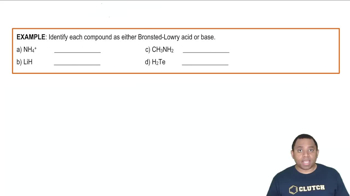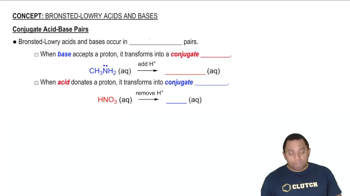Here are the essential concepts you must grasp in order to answer the question correctly.
Net Ionic Equations
A net ionic equation represents the chemical species that are involved in a reaction, excluding spectator ions. It focuses on the ions and molecules that undergo a change during the reaction, providing a clearer picture of the actual chemical process. To write a net ionic equation, one must first write the complete ionic equation and then remove the ions that do not participate in the reaction.
Recommended video:
Brønsted–Lowry Acids and Bases
The Brønsted–Lowry theory defines acids as proton donors and bases as proton acceptors. This concept emphasizes the transfer of protons (H⁺ ions) in chemical reactions, allowing for a broader understanding of acid-base behavior beyond just the presence of hydroxide or hydronium ions. Identifying acids and bases in a reaction helps in determining the conjugate acid-base pairs formed during the process.
Recommended video:
Bronsted-Lowry Acids and Bases Example
Conjugate Acid-Base Pairs
Conjugate acid-base pairs consist of two species that differ by the presence of a single proton. When an acid donates a proton, it becomes its conjugate base, while the base that accepts the proton becomes its conjugate acid. Understanding these pairs is crucial for analyzing acid-base reactions, as they illustrate the reversible nature of these processes and help predict the direction of equilibrium.
Recommended video:
Conjugate Acid-Base Pairs
 Verified step by step guidance
Verified step by step guidance


